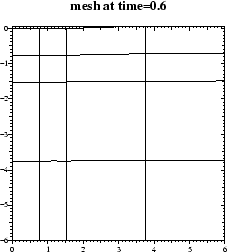In this plane-strain example the Mohr-Coulomb plasticity law
is used to calculate the bearing capacity of a foundation.
The foundation is symmetric, so that only half of the problem is analyzed.
The width of (half of) the foundation is ![]() .
The size of the soil domain is taken to be
.
The size of the soil domain is taken to be ![]() by
by ![]() .
The Young's modulus of the soil is
.
The Young's modulus of the soil is
![]() and the Poisson
ratio is
and the Poisson
ratio is ![]() .
For the Mohr-Coulomb law, both the yield rule angle and
the flow rule angle are
.
For the Mohr-Coulomb law, both the yield rule angle and
the flow rule angle are
![]() ,
and the cohesion is
,
and the cohesion is
![]() .
At the bottom of the domain, all displacements are assumed
to be fixed.
At the left edge (the symmetry axis) and at the right edge, the horizontal
displacement is fixed while the vertical displacement is free.
.
At the bottom of the domain, all displacements are assumed
to be fixed.
At the left edge (the symmetry axis) and at the right edge, the horizontal
displacement is fixed while the vertical displacement is free.
The classical solutions from Prandtl, Coulomb and Terzaghi give for the maximal
average pressure ![]() at the foundation values in the
range
at the foundation values in the
range
![]() up to
up to
![]() .
.
To get the same order of accuracy as in the classical solutions,
a coarse mesh with only sixteen quadratic elements is used.
For optimal numerical stability, the elements are integrated fully
(integration points in the nodes).
The foundation is prescribed a downward velocity of
![]() in
the calculation.
With time steps of
in
the calculation.
With time steps of
![]() the solution is advanced up to time
the solution is advanced up to time ![]() .
First the deformed mesh at time
.
First the deformed mesh at time ![]() is plotted below.
is plotted below.

Secondly, the development for the average pressure at footing over time is plotted
The maximum value of average pressure is near
![]() .
.